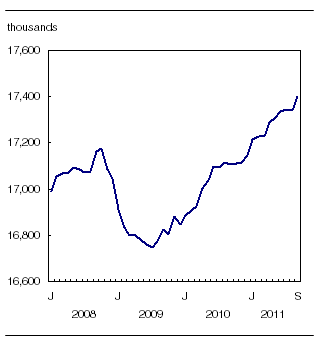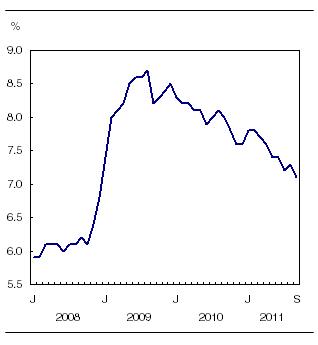Labour Force Survey
Archived Content
Information identified as archived is provided for reference, research or recordkeeping purposes. It is not subject to the Government of Canada Web Standards and has not been altered or updated since it was archived. Please "contact us" to request a format other than those available.
Related subjects
-
[an error occurred while processing this directive]
Following two months of little change, employment rose by 61,000 in September, all in full time. This increase pushed the unemployment rate down 0.2 percentage points to 7.1%, the lowest rate since December 2008.
Employment

In the 12 months to September, employment has grown by 1.7% (+294,000), primarily in Ontario and Alberta. Over this period, full-time employment rose by 2.5% (+344,000), part-time work declined 1.5% (-50,000) and total actual hours worked increased 2.0%.
Note to readers
Labour Force Survey (LFS) estimates are based on a sample, and are therefore subject to sampling variability. Estimates for smaller geographic areas or industries will have more variability. For an explanation of sampling variability of estimates, and how to use standard errors to assess this variability, consult the "Data quality" section of the publication Labour Force Information (71-001-X, free).
Seasonal adjustment and educational services
Unless otherwise stated, this release presents seasonally adjusted data, which facilitates comparisons by removing the effects of seasonal variations.
The LFS seasonal adjustment process removes the "average" seasonal pattern in the monthly data, according to trends seen in the previous few years. While there have been large movements in educational services employment in summer months in recent years, there has not been a consistent pattern in the direction or magnitude of these month-to-month yearly changes.
September's employment increase was spread across a number of industries, with gains in educational services; professional, scientific and technical services; accommodation and food services; natural resources; and public administration. These gains were partially offset by declines in finance, insurance, real estate and leasing; manufacturing; and information, culture and recreation.
There were notable employment increases in British Columbia, Saskatchewan, New Brunswick and Prince Edward Island in September.
In September, employment increased among the self-employed and public sector employees. Compared with 12 months earlier, employment growth in the private sector (+2.2%) was faster than that of the public sector (+1.1%), while self-employment rose slightly (+0.6%).
Unemployment rate

Chart description: Unemployment rate
Service sector leads employment gains
Employment in educational services rose by 38,000 in September (see Note to readers). Compared with a year earlier, employment in this industry is up 1.7% (+20,000).
The number of workers in professional, scientific and technical services rose by 36,000 in September, continuing an upward trend that began in the summer of 2009. Over the past 12 months, employment in this industry has increased by 4.1% (+53,000), one of the highest rates of growth among all industries.
In accommodation and food services, employment was up 31,000 in September. Compared with 12 months earlier, employment increased by 7.6% (+80,000), the highest growth rate among all industries.
Following two consecutive months of decline, employment in natural resources increased by 17,000 in September. This gain brings employment in this industry to the same level as 12 months earlier.
There were also employment gains in public administration (+14,000), bringing employment back to its level of September 2010.
Employment fell by 35,000 in finance, insurance, real estate and leasing. Compared with a year earlier, employment in this industry is down by 1.4% (-15,000).
Following little change in the previous three months, employment in manufacturing was down 24,000 in September. This decline leaves employment slightly above its level of September 2010 (+0.8% or +13,000).
There were also declines in information, culture and recreation (-22,000). Despite September's decline, employment in this industry increased by 1.5% (+12,000) compared with 12 months earlier.
While employment in construction was little changed in September, it was up 4.1% (+50,000) from a year earlier, one of the highest growth rates of all industries.
Large gains in British Columbia
Employment in British Columbia rose by 32,000, all in full-time work. This was the first notable employment gain since July 2010. The unemployment rate fell by 0.8 percentage points to 6.7% in September.
In Saskatchewan, employment increased by 4,000 in September. Employment in the province is up 0.9% compared with 12 months earlier, lower than the national average of 1.7%.
Employment increased by 2,700 in New Brunswick. Despite this gain, employment in the province was 0.5% lower than 12 months earlier.
While employment in Alberta was little changed in September, over the year, employment has grown by 4.8% (+98,000), entirely in full-time work.
Employment in Quebec was unchanged in September. With fewer people searching for work, the unemployment rate fell by 0.3 percentage points to 7.3%. Compared with September 2010, employment increased by 0.6%.
Ontario employment was little changed for the second consecutive month and the unemployment rate was 7.6%. Over the past 12 months, employment increased by 2.0% (+136,000), above the national growth rate of 1.7%.
Increases among core-aged and older workers
Employment increased among workers aged 25 to 54 in September (+25,000), bringing growth over the previous year to 1.2% (+146,000).
In September, employment grew by 21,000 among workers aged 55 and over. Employment for this age group is up 2.7% (+81,000) in the past 12 months.
Employment among youths aged 15 to 24 was up slightly, bringing growth since September 2010 to 2.8% (+68,000).
Quarterly update for the territories
The Labour Force Survey also collects labour market information about the territories. This information is produced monthly in the form of three-month moving averages. Not all estimates are seasonally adjusted; therefore, comparisons should only be made on a year-over-year basis.
Employment in the Northwest Territories rose by 1,500 (+6.7%) from the third quarter of 2010 to the same period in 2011. Employment was little changed in both Yukon and Nunavut.
In the third quarter of 2011, the unemployment rate was 7.4% in the Northwest Territories, 4.9% in Yukon and 17.2% in Nunavut.
Available on CANSIM: tables 282-0001 to 282-0042, 282-0047 to 282-0063, 282-0069 to 282-0095 and 282-0100 to 282-0121.
Definitions, data sources and methods: survey number 3701.
A more detailed summary, Labour Force Information (71-001-X, free), is now available online for the week ending September 17. From the Key resource module of our website under Publications, choose All subjects, then Labour. LAN and bulk prices are available on request. The DVD-ROM Labour Force Historical Review, 2010 (71F0004X, $209), is now available. See How to order products.
Data tables are also now available online. From the Subject module of our website, choose Labour.
The next release of the Labour Force Survey will be on November 4.
For general information or to order data, contact Client Services (toll-free 1-866-873-8788; 613-951-4090; labour@statcan.gc.ca). To enquire about the concepts, methods or data quality of this release, contact Jason Gilmore (613-951-7118; jason.gilmore@statcan.gc.ca) or Vincent Ferrao (613-951-4750; vincent.ferrao@statcan.gc.ca), Labour Statistics Division.
- Date modified:
